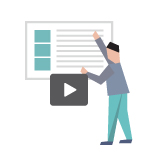It’s well known that a content strategy is a great lead-generation tool, but many marketers fail to recognise that it can be a powerful sales enablement tool as well. By focusing on creating sales content that provides valuable information for your prospects, you’ll be able to generate, educate and qualify leads before they’ve even made contact with your sales team.
Marketing content attracts leads, but sales content converts them into customers.
Encourage your sales and marketing teams to align their efforts when developing a content strategy. With the right data and insights from your sales team, your marketing team will be able to create content that nurtures and qualifies leads, while allowing you to show your customers why your brand is the most qualified to solve their problems.
Here’s how you can create sales enablement content that sells for you.
Click here for the ultimate guide to B2B sales and marketing alignment
What is sales enablement content?
It’s been found that 80% of purchasing cycles are completed before customers even consider contacting the vendor. This means that it’s becoming more and more important for businesses to produce content aimed at sales enablement.
While content marketing attracts potential customers and keeps your brand top-of-mind, it’s up to your sales content to nurtures leads and convince customers why they should choose your brand over the competition.
By offering useful information that’s relevant to the needs of your target audience, you can educate your customers while building loyalty for your brand.
A customer that feels as though your business understands their needs and empathises with their pain points, is more likely to trust you. Brands that can answer your customers’ questions without even needing to be asked, demonstrate that they have the knowledge to solve their problems.
Sales-enablement with assignment selling
Assignment selling is the process of using educational content to answer the critical questions that your target audience has about your products or services.
Before your customers can even consider making a purchase, they’re going to have a lot of questions. The answers to those questions may be the difference between a prospect making a purchase or not.
Without being able to separate qualified leads from unqualified ones, sales teams end up taking a lot of calls and answering many questions from leads at various levels of sales-readiness, who may not even know if they’re interested in buying yet. Calls from unqualified leads who are never going to convert are a waste of time, effort, and resources that could be better spent nurturing qualified leads.
Assignment selling allows your leads to self-qualify by giving them all the answers and information they need to make a purchasing decision before they’ve even picked up the phone. This ensures that the majority of calls that make it through to your sales team are already qualified leads who are ready to make a purchase.
Assignment selling allows you to reduce the number of calls spent with the wrong people, while increasing close-rates and boosting your revenue.
How to use assignment selling in your content strategy
Assignment selling should be a collaborative effort between your marketing and sales teams.
By working together, your team can develop relevant and useful content that qualifies leads, gets your customers sales-ready, and helps grow your revenue. Here’s how your team can develop an assignment selling strategy that enables sales:
What sales enablement content should you be creating?
Sales content comes in many different shapes and sizes, and you’ll need to review your content marketing strategy to know what’s working. By analysing your data, you can see what content your target audience is responding to, and what topics are producing the best results.
With this information, your sales team can make data-driven decisions about what content will nurture leads and ultimately close the sale.
Here are just some of the types of sales enablement content you could be using:
|
|
Blogs, Vlogs and Podcasts Blogs, vlogs and podcasts are an excellent way to answer the questions that your leads are asking. Remember, traditionally it’s been the job of your sales team to answer these questions over the phone, so make sure your marketing and sales team are collaborating closely when producing this content. Blog, vlogs and podcasts can break down relevant information into bite-sized chunks that your customers can browse through to find the information they’re looking for. You may even consider dedicating a blog article to each of the questions that your audience is asking so that you can explore each topic in-depth. |
|
Whitepapers and eBooks Sometimes the information your prospects need to know to make a purchase is a little too complicated for just one blog article. This is where eBooks and whitepapers can offer a deeper exploration of the information your audience is looking for. Not only are eBooks and whitepapers excellent for educating leads and getting them sales-ready, they can also help you earn their trust. Offering a free eBook that benefits your prospects without asking for anything in return is like giving a gift, and it can strengthen relationships with your brand. |
 |
Customer Case Studies The best way to prove to your customers that you can help solve their problems is to show them examples of how you’ve solved the problems of others like them. Case studies are a powerful way of demonstrating how your product or service works, and they can show your customers just what they stand to gain by choosing your brand. It’s best to collect a variety of case studies across the full range of industries you work with, and demonstrating all the problems you can solve. This will allow you to offer relevant examples to all of your customers, no matter who they are, or what they need. To produce effective case studies, your marketing team will need to work with your sales team to collect data, insights, anecdotes and testimonies from your customers. |
Sales content for prospect meetings
Your sales content doesn’t just need to educate your customers, it can be an indispensable resource for educating your sales team as well.
The more your sales team understands your products or services, the better prepared they’ll be to sell them to your customers in their sales meetings. For this reason, you should offer your sales team internal content and reference material that helps them convert leads into customers.
 |
Sales Playbooks Sales meetings need to feel personal to your prospects. If your customers feel like your sales rep is just reading off a script, they’re going to lose interest very quickly. Every sales meeting is different, and a sales rep needs to be prepared to adapt to suit the needs and interests of each prospect. If you sales rep can’t answer the questions they’re being asked, it won’t be long before your customer starts to doubt that they know what they’re talking about. Doubt can kill a sale. A sales playbook can outline the sales process and the key points your sales rep should touch on, without restricting them to an inflexible script. This will give your sales team clear guidance for their sales meetings, while encouraging them to put a bit of personality into their calls. Offer your team guidelines, but leave room for adaptation. |
 |
Product Specifications and Video Demonstrations Product specifications, technical data sheets and video demonstrations can help your sales team and your prospects answer some of the most pressing questions about your product or service:
|
 |
Competitor Evaluations and Analysis Competitor analysis can help direct your brand positioning and USP so that you can stand out from the competition. In order to make an offer that your prospects can’t refuse, you have to understand what your competitors are already offering. By providing competitor analysis for your team, you can show them where your brand stands in the industry, and what they need to do to stand out in it. |
Sales Content that Closes Deals
Your content strategy is designed to attract leads, but it’s up to your sales team to close the deal, and sales content can help them do it.
 |
Email Templates Statistics have shown that email marketing still returns the best ROI for your spend, with an average of $42 for every $1 spent. But email marketing isn’t easy, and your sales team will need a bit of direction on how to develop emails that convert. Guide your sales team with email templates that save them from having to build every email from scratch. Whether you’re sending follow-up emails, outreach emails or ‘thank you’ emails, you should develop a template for each one so that every email is professionally designed and based off solid marketing research. |

|
Documents and Presentations Sales collateral such as corporate brochures and flyers can help spread awareness and boost sales by offering a physical document for your prospects to browse. These are typically produced by your marketing team and should be based on the insights that your sales team can provide about what your customers need to know. |
 |
Social Media Communications Social media allows you to interact directly with your prospects to answer their questions, nurture leads, and build brand loyalty. With your sales and marketing teams working together to develop data-driven, omnichannel sales and outreach campaigns, you can use social media to gently guide your prospects through each stage of the buying cycle, right through to purchasing. |
A Content Strategy That Attracts, Nurtures and Converts Leads
Your content strategy has the power to do more than just attract leads, it can also get them self-qualifying and sales-ready by the time they organise a meeting with your sales team.
The combined knowledge and efforts of your sales and marketing teams can help you develop a content strategy for sales enablement that attracts, nurtures and converts leads for a better ROI.
Key Takeaways
- A strong content strategy can lead customers right through each stage of the buyer journey, all the way to purchasing.
- Content marketing attracts leads. Sales content converts them.
- Content can be used to generate trust and develop brand loyalty.
- Assignment selling will save your sales team time by answering the most common questions your prospects are asking before they have to ask them.
- Your content strategy should be a collaborative effort with the data and insights from your sales team directing the content decisions of your marketing team.
- Different types of content deliver different results. It’s best to work out what forms of content your prospects are engaging with.
- Sales content can educate your team just as much as it can educate your customers.
Strong content strategies are a collaborative effort between sales and marketing
Want to know how to get your sales and marketing teams working together to produce great content that enables sales?






